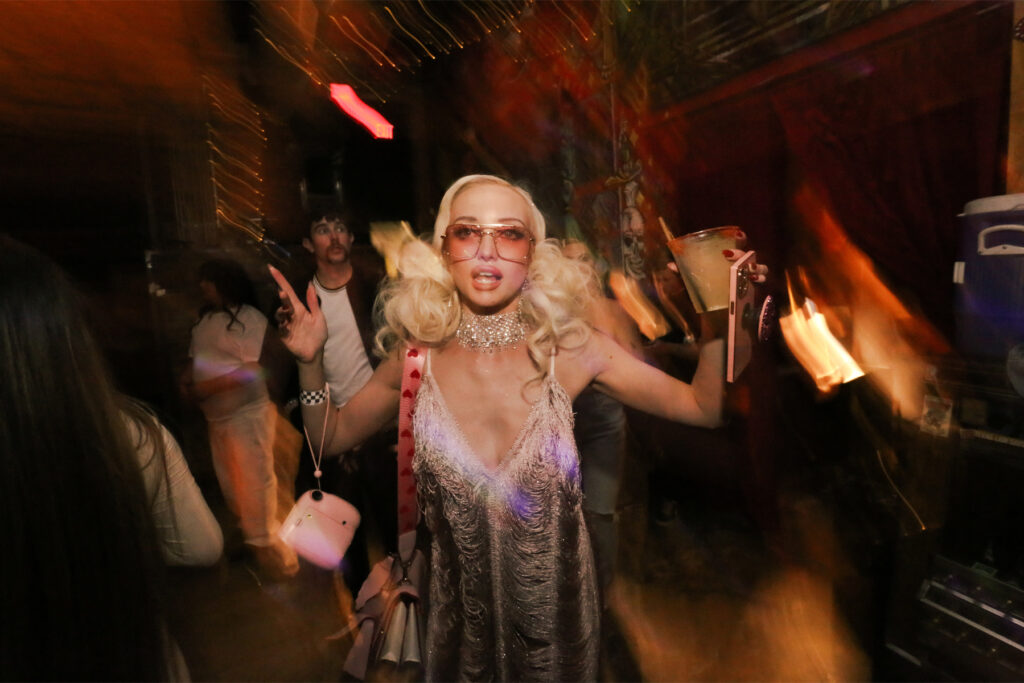DJ Blake Ward and Xa’Pariis Ebony met at a drag show in Dallas put on by Disco, TX. Ebony, a member of the House of Ebony, had been hired to vogue. Ward, known for throwing some of the best parties in Dallas, was the DJ for the event. It was right before the pandemic, and the two performers were impressed by each other’s professionalism. That night, they showed interest in working together in the future.
But when Ward later tried to reach out to Ebony, he was unable to track him down. What Ward didn’t realize was that since their initial encounter, Ebony had been competing in the first season of HBO Max’s Legendary, the first reality series competition to center on ballroom culture.
They wouldn’t run into each other again until Ebony showed up to perform at one of Ward’s birthday parties. Unbeknownst to Ward, the man he had tasked with finding vogue performers for the party, JRock, was Ebony’s father.
After the event, Ward, who has a personal love of vogue music, approached Ebony with the idea for Climax, a weekly dance party that brings ballroom to the forefront of Dallas nightlife. The vision—an event where everyone is welcome and emergent talent is uplifted—appealed to Ebony. “Based on my background, expertise, and experience I have had in the culture, coming across someone like Blake isn’t something you see often,” he says.
For Ward, Climax is an opportunity not only to work with Ebony but to share his years of experience in promotions with him. “I have had my moment in the sun,” Ward says. “There are so many talented performers in Dallas that I want to showcase. Now I can do something with an actual vogue artist, uplift them, and help me by throwing cool parties.”
Ebony, too, is excited by the possibilities. “On the East Coast, much of the LGBTQ community comes out to balls,” he says. “Here in the South, most of our community is exposed to pageants and the club scene first. What is developing here in our region is a lot of fresh talent. They do not know how to get the exposure the ballroom could bring them.”
In recent years, members of the ballroom community have landed career-altering opportunities in film, TV, and fashion. Dominique Jackson, a guest judge on Legendary and cast member of FX’s Pose, is one of the faces of Mugler’s spring/summer 2022 campaign. Jack Mizarhi, a 30-year ballroom veteran, is an executive producer on Legendary and wrote for Pose. Leiomy Maldonado, a judge on Legendary, has worked with Fitbit, Nike, Nine West, and walked in New York Fashion Week for The Blonds. Dashuan Wesley, host of Legendary, has performed alongside superstar Rihanna and participated in campaigns for T-Mobile, Malibu, and luxury brand Lanvin.
The energy is there. Down south, ballroom has found a home in Austin and San Antonio. The House of Lepore hosted its inaugural ball at this year’s South by Southwest festival. The Dirty South Ball showcased houses from across the state, including Dallas’ House of Amazia. Papi Lepore, a member of the House of Lepore, participated in the second season of Legendary with the House of Luxe. Prior to Lepore, Papi helped throw the first ball in San Antonio under the House of Kenzo.
Climax creates a space for that energy and community here in Dallas. As for its future, Ebony says he hopes it will “put Dallas and the Gulf Coast on the map as ballroom.” Ward aspires for the party to be a place for radical self-expression. There are plans for national ballroom DJs and performers to visit in the future, but, until then, the party continues every Friday night at Ruins.
Suddenly in Vogue
What was once underground is now prime-time TV.
In recent years, ballroom has achieved mainstream success through award-winning series such as FX’s Pose and VH1’s RuPaul’s Drag Race. Ballroom icons Leiomy Maldonado and Dashaun Wesley host HBO Max’s Legendary, while Demi Lovato and Megan Thee Stallion have served as guest judges. But despite the recent hype, drag balls are nothing new. They trace their origins to post-Civil War Harlem, where female impersonators would compete in gowns before a panel of judges, pageant style. By the 1930s, as many as 8,000 spectators were attending events. By the early 1970s, a thriving “house ball” subculture had emerged in New York, where Black and Latino LGBTQ performers could express themselves freely and compete with their chosen “house” (more of a family than a team) through drag, dance, and other forms of expression.
Get the FrontRow Newsletter
Author








